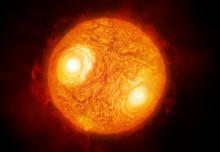Listen to today's episode of StarDate on the web the same day it airs in high-quality streaming audio without any extra ads or announcements. Choose a $8 one-month pass, or listen every day for a year for just $30.
You are here
Moon and Antares
A flickering stellar giant stands to the lower right of the Moon this evening. Bright orange Antares is one of the biggest stars in the galaxy. If it took the Sun’s place in our own solar system, it would engulf the four innermost planets, including Earth. Yet Antares won’t be around for long — it’ll explode sometime in the next million years or so.
That fate is determined by the star’s mass. Antares is at least 15 times as massive as the Sun. Such a heavy star burns through the nuclear fuel in its core in a hurry. Antares has already consumed its original hydrogen to make helium. Now, it’s probably burning the helium to make carbon.
This process makes Antares a bit unstable. Its surface appears to pulse in and out, causing its brightness to vary by about 30 percent. Unlike many other pulsating stars, though, it’s not a steady beat. So there’s no way to predict how bright the star will appear at any particular time.
That may mean that it’s not the entire surface that pulses, but individual blobs of hot gas. Some of the blobs can be as big as a small star. They percolate to the surface like bubbles in a pot of boiling water, carrying heat from deep inside Antares. These hot blobs are brighter than the surrounding gas. So they may add to Antares’s luster before they cool and sink back into the star. With many bubbles rising at different times, that could change the star’s overall brightness in unpredictable ways.
Script by Damond Benningfield




